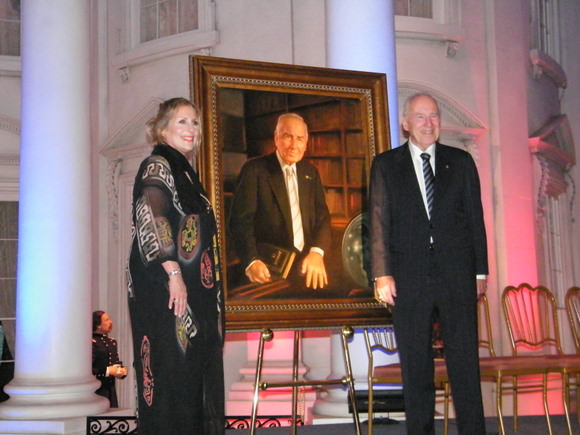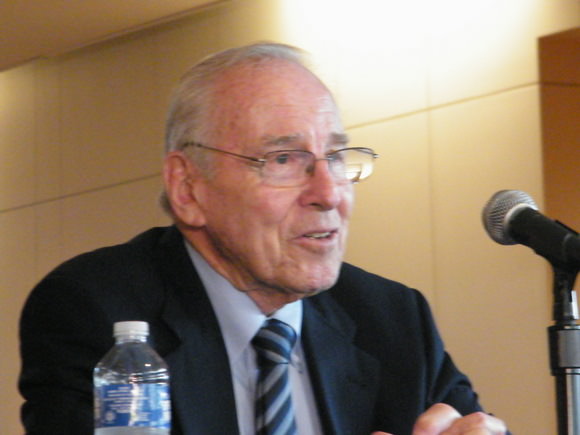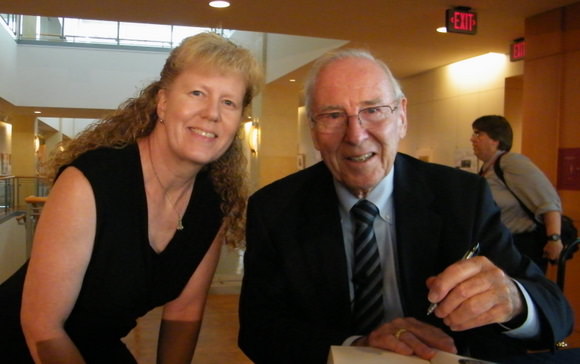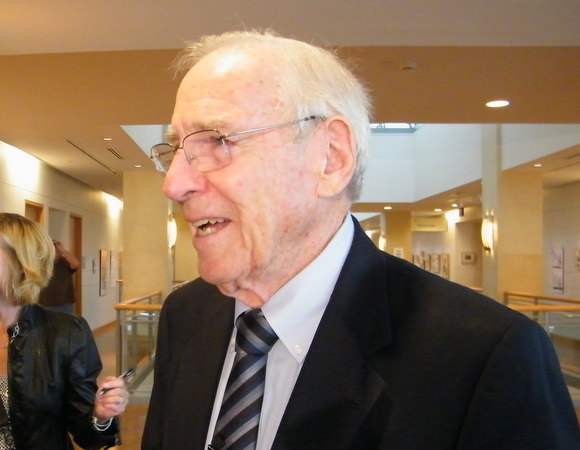[/caption]
Apollo astronaut Jim Lovell was awarded the Lincoln Leadership Prize by the Abraham Lincoln Presidential Library and Museum foundation last week, and while humbled to receive the award, Lovell said he really is just an ordinary person. “I was just at the right place at the right time with the right credentials; there was nothing so extra special about me that got me where I am.”
But those in attendance at a reception to unveil a portrait of Lovell which will hang at the presidential library in Springfield, Illinois said Lovell embodies the intersection of heroism and legacy.
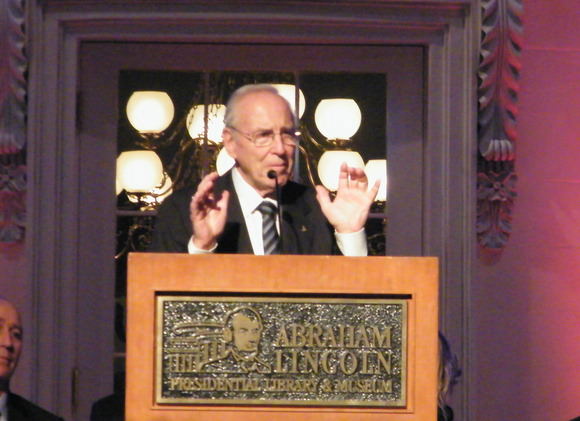
“NASA had a leader at the exact moment they needed it,” said Richard K. Davis, Chair, President and CEO of US Bancorp, who introduced the former Apollo astronaut at the reception. “With the help of many, Lovell and his crew created the outrageous but amazing solution to plot Apollo 13 back home. NASA found they had a cool, calm, competent leader, a hero who took this crew and a nation from ‘Houston we have a problem’ to America, we have a miracle.
Davis said one of his all-time favorite quotes comes from Lovell: “There are people who make things happen, there are people who watch things happen, and there are people who wonder what happened. To be successful you need to be a person who makes things happen.”
Earlier in the week, Lovell talked with members of the media about his life and his thoughts on NASA’s current budget situation. You can read part one of the interview here, and following is the continuation of the conversation with Jim Lovell, where he talks about some of his memories of his flights to space, and what it took for him to realize that Apollo 13 was more than just a failure:
We’re coming up to almost the 40th anniversary of the last person who landed on the Moon—what are your thoughts about that?
Lovell: It is a rather sad remembrance. I think it is an end of an era. I think the anniversaries will end—we probably won’t get together much anymore. We should look ahead to have a space program that everyone can be proud of, regardless of what it ends up to be. Sometimes we live too much in the past. But the future is here.
Why did you decide to become an astronaut?
Lovell: When I was in high school I was interested in both astronomy and rockets. There was a fellow I admired, the father of modern rocketry named Robert Goddard. I really wanted to be a rocket engineer. So I wrote to the secretary of the American Rocket Society, and asked how I could become one. He told me there was no school at that time that offered that type of study specifically, but I should take mechanics and mathematics, thermodynamics and either go to MIT or CalTech.
But my father had died earlier that year and I didn’t have the money to go to either of those places, so I gave that up. But I did apply to get an ROTC scholarship and was accepted. I went to the University of Wisconsin for two years and won an appointment to the Naval Academy. I went there for four years and got into the Navy and became a naval aviator – which was a second goal for me, as my uncle had been a naval aviator and had regaled me with all his stories. Then I went to test pilot school for the Navy. And when NASA was asking for astronauts, it seemed to me to be the perfect opportunity: here was a marrying of flight and rockets all coming together for me as if I had planned it all this time.
You couldn’t have seen a more disappointed person when I wasn’t selected for the first original seven astronauts. I made it to the final 32 candidates. But then, for round two, I was selected.
Universe Today: What are your favorite memories from your four flights to space?
Lovell: Apollo 8 was the most inspirational flight to me, and I hope it brought a message back to the Earth of what we have.
The most impressive sight I saw was not the moon, not the far side that we never see, or the craters. It was Earth. The Earth was the most impressive sight. As we came around the far side of the Moon and saw the Earth come up above the horizon, we could see the only color in our part of the Universe. The blues of the oceans, the white clouds, the tans, the pinks. I could put my thumb up and hide the Earth completely. Then it dawned on me how completely insignificant we are. Everything I had ever known – my family, my country, my world – was behind my thumb.
So there in the distance was this small body orbiting a rather normal sun, — nothing so particular about it — tucked away on the outer edge of the galaxy we call the Milky Way.
I thought how fortunate we are to live on this small body, with everyone – all those ‘astronauts’ — living together like on a starship, with limited resources. So, in a way that was just like Apollo 13, and we have to learn to live and work together. And I hope we could bring that message back to the people of Earth.
But I also have to say one of my other favorite memories was from Apollo 13: the splashdown! Seeing the parachutes, feeling the capsule swaying in the ocean, and having one of the divers come to knock on the window was a great feeling. It was pretty impressive, too.
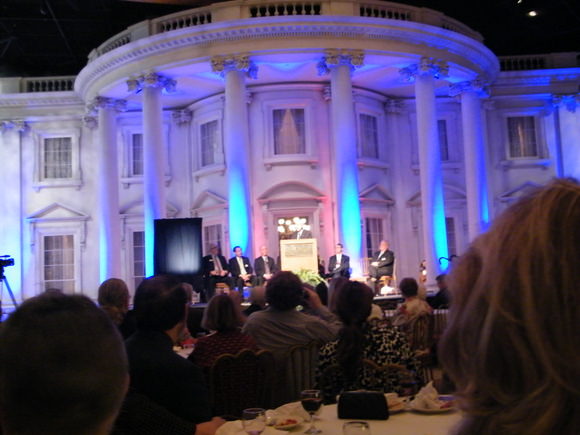
What was scarier, the explosion of Apollo 13 or seeing the service module after it was jettisoned and wondering if the heat shield was still intact?
Lovell: The low point was the explosion – which we didn’t realize was an explosion until I saw the oxygen leaking outside the spacecraft, and saw from our instruments that we would be completely out of oxygen. This also meant we would be out of electrical power, and because we used the electrical power to control the rocket engine, we also lost the propulsion system. We knew we were losing the command module, but that was the only thing that had the heat shield to get us back to Earth.
As we were going through and solving all the problems one by one, when we came back towards Earth and jettisoned the Service Module and saw the explosion had blown out the entire side panel, we wondered about that heat shield which was right behind us, if the explosion had cracked it. But there was nothing we could do at that point. There was no solution. You just crossed your fingers. Once we entered the atmosphere we just had to hope the heat shield was intact. And it was.
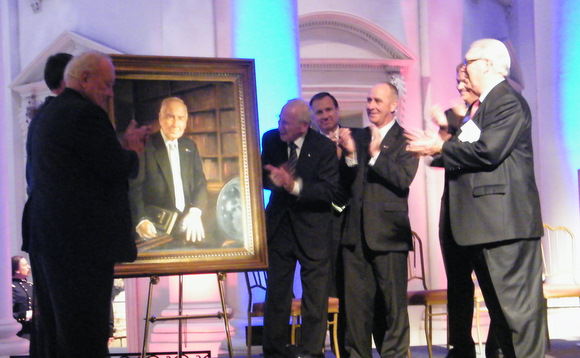
You went from the space program to the tugboat business. What was that like?
After I retired from NASA and the Navy, and I was looking for something to do. I went to the advanced management program at Harvard and learned enough about business to be dangerous. Some friends of ours had a tugboat company and he offered me a job leading the company. Since I was a Navy officer — which has something to do with ships and water – I thought I could handle that. I was in that about five years. Then I got into the telecommunications business, which was fortunate timing because the deregulation of AT&T was just around the corner. We sold digital systems, where AT&T had analog systems, and we could sell the systems instead of how it was done the past where customers leased equipment from the phone company.
As you sit in this museum and library, what are your thoughts about studying the past?
This library and museum is not just something to look back on the era of Lincoln, it is an education for all ages coming through here of how we can keep the country together in the future. At the various museums around the country, like at the Air and Space museum, we show what people have done in the past in spaceflight. Here, and there, we show how people are committed to do things. Lincoln was committed to preserve the country. This type of an institution gives young people the chance to learn about those who were committed to make our country strong, and it should give everyone hope about our future.
You didn’t write the book “Lost Moon” for over 20 years after the Apollo 13 mission. What took so long?
Lovell: When we first got back from Apollo 13, the three of us astronauts said, this was a pretty unusual flight, so we should write a book about this. So, we said, we’re going to get together and write something. Well, as it often happens, as time went on, we all had jobs to do and life got busy for all of us. Jack Swigert went into politics in Colorado, and then, of course, he passed away. Fred Haise went into the aerospace business with Grumman, and I went into the telephone business. But just after I retired I got a call from a young man (Jeffrey Kluger) who said he had never written a book before, but he was a science writer for the Discover Magazine.
To make a long story short, I liked the way he wrote and we got together and wrote the book about 22 years after Apollo 13. But you have to remember that Apollo 13 was a failure. I mean, the only experiment that was completed was really done by the mission control team when they maneuvered the third stage of our booster to hit the Moon so that the Apollo 12 seismometers could pick up the results of the hit to learn something about the lunar surface. So there were no other successful experiments. The only thing we were doing was trying to figure out how to get home.
So, for years after we got back, I was frustrated. I wanted to land on the Moon like the other crews had, but I didn’t. But as we started to write the book, I realized that in its initial mission, yes, the flight was a failure. But as we wrote and I found out more about how hard the mission control team worked to get us back, I realized it really was a triumph in the way people handled a crisis: good leadership at all levels at NASA, teamwork that was generated because of that leadership, the use of imagination and initiative to figure out how to get us home by using just what we had on board, the perseverance of people who kept on going when it looked like initially that we didn’t have a chance. Jules Bergman (ABC science reporter) only gave us a 10 per cent chance, and my wife never forgave him for that!
But this is why Apollo 13 went from being a failure to a triumph.
The movie is very accurate, by the way. Ron Howard followed the real story very well. All the incidents were true except for the argument between Haise and Swigert, but Ron Howard had to figure out a way to portray the tension we all felt, and decided to do it in that way.
Previous winners of the Lincoln Leadership Prize are archbishop Desmond Tutu and Supreme Court Justice Sandra Day O’Connor. For more information about the Lincoln Prize and the Presidential Museum and Library, see the ALPLM website.

